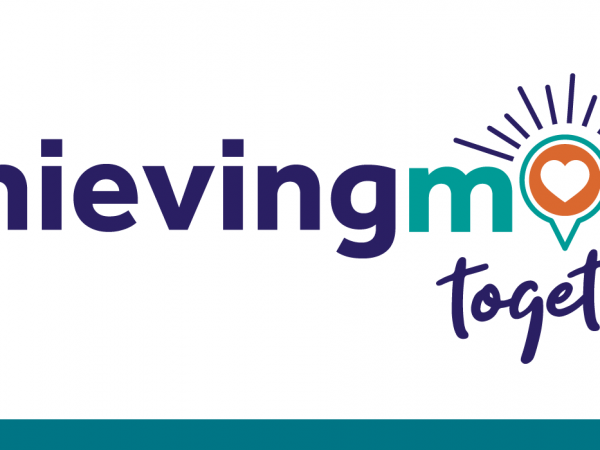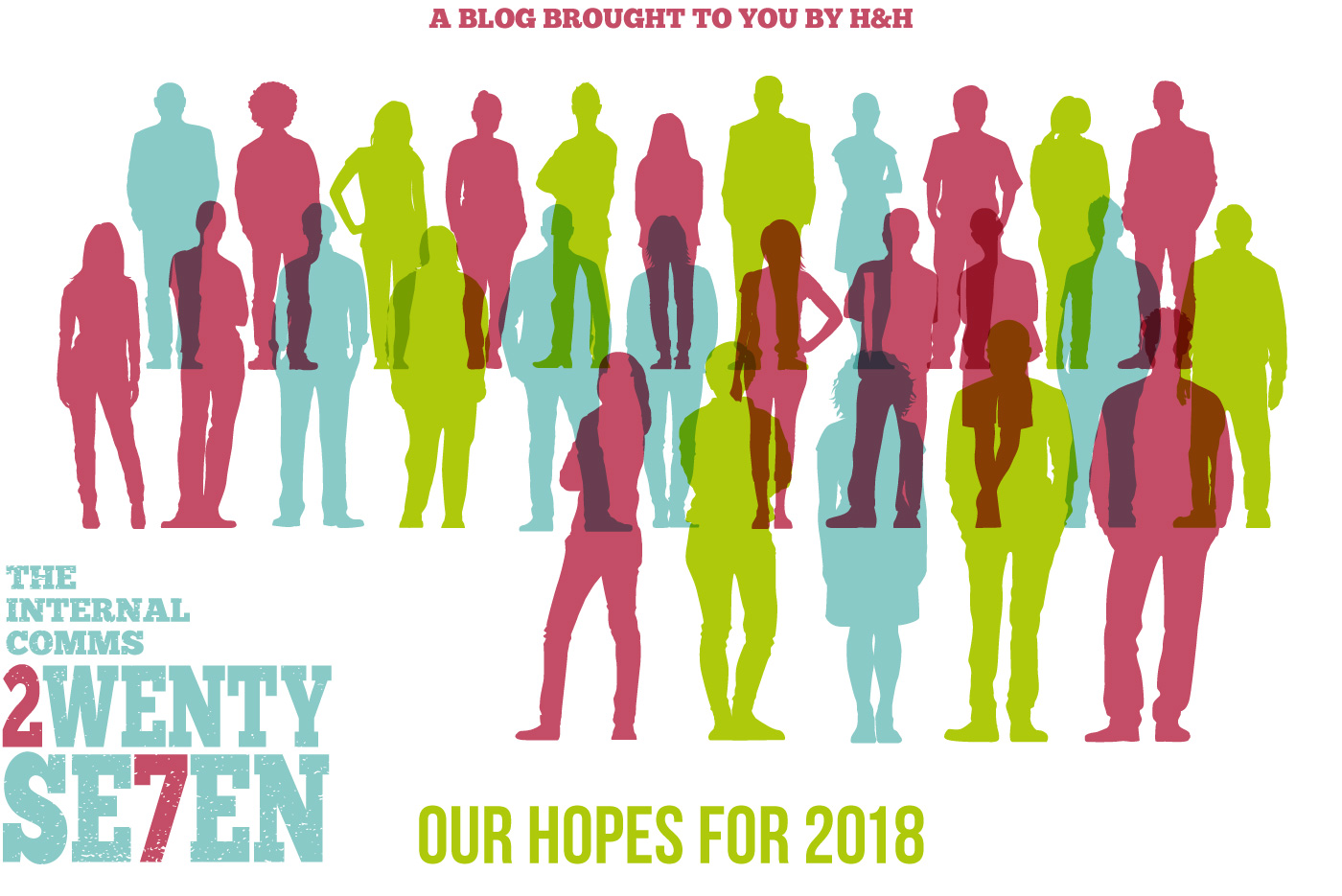
‘What are your hopes and aspirations for the internal comms industry in 2018? That’s the question we put to 27 internal comms professionals from across the globe – and here’s what they told us. Read on for some fascinating insights and predictions!
Riding on the back of 2017, there’s a lot of hope abounding that 2018 will be an even better year for the internal communications industry.
We’re closer to solidifying internal comms’ reputation as a critical strategic enabler for employee engagement and organisation success.
We’re increasingly being called upon by business leaders to lend our advice and expertise.
And we’re taking steps – albeit baby steps – towards cracking the measurement conundrum.
Add to that the recent Edelman Trust Barometer’s revelation that public trust and confidence in CEOs has risen significantly from the worrying dip in 2017 – and there’s a lot that internal communicators everywhere can proudly shout about as we welcome the year ahead.
Predicting internal comms challenges for 2018
But as we discussed in our recent blog, The top 7 IC challenges of 2018, there’s still plenty of issues standing defiantly in our way.
Senior leaders are struggling to inspire and engage their employees in the organisation’s mission. There’s still a concerning lack of budget and resources being afforded IC teams, despite belief and confidence in the value of IC being at an all-time high. And the old chestnuts of manager communication, strategic discipline, and data collection are all still nipping at our heels.
Luckily, internal communicators don’t need to face these challenges alone.
We asked esteemed IC professionals where they sit on these matters – along with their views and predictions on what the industry should be doing in 2018.
And we’re glad to say we got a whole lot of responses (thanks everyone!).
We asked one simple question:
What are your hopes and aspirations for the internal comms industry in 2018?
From the responses we identified 6 core categories.
1. Rethinking internal comms strategy
2. Integrating new technologies
3. Addressing measurement
4. Improving the profession and its reputation
5. Building management and leadership capability
6. Forging deeper connections
To make it easier and give each entry a clear area of focus we have broken them down to fit under one of these sections.
Some responses do include reference to more than one, but primarily will be about the category they sit in.
In the interests of fairness and respect for our wonderful global community, we’ve opted to keep local spelling variants throughout this article.
And so without further ado, we’ll hand you over to our professional IC contributors.
Before we dive in, did you know you could be receiving an exciting dollop of IC inspiration every week?
Subscribe to our Friday Ketchup to get handpicked internal comms and employee engagement insights, facts, and ideas squeezed straight into your inbox, every Friday.
Here’s what they said…
1. Rethinking internal comms strategy
Jim Shaffer
Business advisor, leadership coach, author and speaker
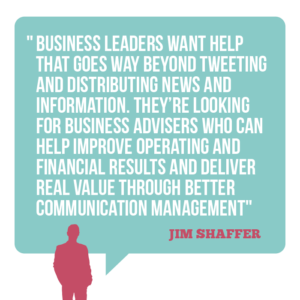
I hope that internal communications professionals will learn from many of their HR colleagues who’ve shifted from low value-adding personnel administration tasks to high-value work that builds employee capabilities.
Business leaders want help that goes way beyond tweeting and distributing news and information. They’re looking for business advisers who can help to improve operating and financial results and deliver real value through better communication management.
“Internal communication professionals can and should stop churning out activities that may look, feel and sound good but have no impact on what matters to customers, employees and shareholders.”
It starts with knowing what to measure. It’s not about retweets, page views, channel usage, clicks-to-open or the number of visits to your website or social media. It’s about improving product quality, service delivery, costs and other measures that matter to the business.
If internal communication practitioners stay focused on removing communication barriers that make it hard for people to do their work, they’ll be on the track to huge success in 2018.
We know it’s doable because many are doing it.
Alejandro Formanchuk
Director, Formanchuk & Asociados, President of the Argentinian Internal Communication Association, and Director of the Ibero-American Internal Communication Federation
In 2018, I hope that internal communicators will not just produce messages or create media – as if they were an internal news agency – but will also coordinate, train, advise and guide all the employees in their organisation to be the primary internal communicators.
Why? Because the historical role of an internal communicator has always been to distribute messages, but today I think we need to conjoin this role with another: to help other people to become the messengers.
That is to say, I hope we’ll change from being a mere fuel, to being a lubricant.
Amit Joshi
Communication Consultant, Yorkshire Housing

In 2018, I hope to see more internal communicators with a seat at the table. Understanding what direction the business is going in helps communicators to have more engaging and relevant conversations with employees and internal stakeholders.
In addition, I want us to make use of the most appropriate and up-to-date platforms. We should analyse how we are communicating and seek to understand the modern techniques that can be implemented to improve employee engagement.
“For example, incorporating adaptive microlearning, cognitive science and gamification techniques to take the boring out of corporate messages and get employees excited to participate.”
Finally, in 2018 we need to understand and predict what’s best for the organisation, employees and stakeholders, and adopt techniques that can measure the impact that communications are having.
Sean Williams
Vice President and Practice Lead, True Digital Communications
My hope for the coming year is that we will continue our progress in unifying our IC practice as a strategic function of our organizations.
That means both improving our execution (we have to be outstanding at the tactics; that’s “table stakes”) and embracing our roles as the communication experts of our organizations.
The strategic value of outstanding IC lies in these two actions. If we do one and not the other, we risk being seen as a “warm-fuzzy” for employees rather than an essential asset that helps the organization attain business objectives.
To make that happen, I hope that we firmly root our strategies and tactics in research and data.
As one CEO told me, ‘You don’t have to prove to me that communication is important, but you do have to prove that the strategy you’re following will help us beat our competition and meet our objectives’. As internal communicators, we’ve gotten away too long with “trust me” as a strategy.
“Excellent execution requires excellent strategy, and research is how we get there.”
To be seen as the internal experts in communication, we have to understand it as a process. For many of us (including me!) we come to communication from other disciplines.
So though we hold the title, we may not understand the theoretical underpinnings of our practice and how to apply them in practice.
But we have to treat our discipline as seriously as our friends in finance, law, and HR treat theirs.
That’s my biggest hope of all – that we endeavour to create a true professional practice of IC, with standards that lead to consistency amid creativity.
Charlotte Sahami
Internal Communications Manager, Principality Building Society
As companies work harder to attract talent and retain staff, internal communications is becoming more broadly understood and recognised as a key strategic function in creating positive cultures and high-performing teams.
As the employee experience becomes more of a focus for businesses, my hope for this year is that we become a more widely valued and recognised function, and less people ask us the dreaded question: “what is it you actually do?”.

In 2018 I want internal communicators to continue to follow marketing-led trends and cut down on corporate waffle.
I predict we’ll be using video a lot more to create more imaginative and engaging communications. I’m also predicting that internal communicators will harness the power of the employee voice to develop peer-to-peer communications, moving away from the old days of top-down comms.
In my organisation we’ve had excellent success with Yammer and internal ambassador programmes over the last year, so I hope other businesses will be doing the same this year!
Sia Papageorgiou
Director, Strategic Internal Communication & Digital Media, Cropley Communication
I encourage internal communication professionals to start the new year by taking a step back and making sure they’ve got the basics right.
We’ve come a long way in internal communication – but not far enough. Many IC professionals are still so focused on volume and outputs that there is little time to focus on outcomes and the areas within their organisations that demonstrate a return on investment.
Yet the same organisational problems keep surfacing – building leadership communication competence, giving employees a voice and having meaningful conversations with them, getting your organisation’s story and strategy straight (who are you, what do you stand for and where do your employees fit in), and creating purposeful communication by aligning your communication with business strategy.
“That’s where internal comms can make a profound and lasting impact on employees, leaders, and the organisation.”
That’s when senior leaders start taking notice and begin to value internal communication as a strategic business function.
And that’s when you earn yourself the role of trusted advisor and business leader within your organisation.
Mike Klein
Principal, Changing the Terms
If I could have two internal communication wishes for 2018, here’s what they would be:
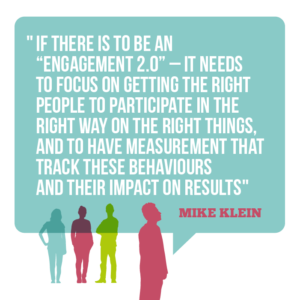
From “engagement” to “participation”
The pursuit of employee engagement is not going away – but there are opportunities to shift it away from emphasizing attitudes and towards prioritising actions and actual behaviors.
If there is to be an “Engagement 2.0” – it needs to focus on getting the right people to participate in the right way on the right things, and to have measurement that tracks these behaviors and their impact on results.
If by the end of the year, “engagement” increasingly means “participation”, we will have had a great 2018.
Better integration of informal and formal leadership
While I have long focused on the value of identifying and mobilizing informal influencers as key to accelerating communication’s impact and success in organizations, I think the time has come to focus on the next step – to better integrate the informal and formal sides of the organization.
The core activity remains the rigorous identification of key informal influencers through organizational network analysis or snowball surveying, and then finding ways for them to interact meaningfully with ambassadors, senior leaders and managers.
This approach won’t only make better use of the informal side of internal communication, but it can also breathe new life into traditional comms approaches – such as cascading – by making them more interactive and resilient.
Dennie Theodore & Maryjane Martin
Mentor and Speaker & Founder and Chief Consultant at Maryjane Martin & Company
In 2017, we conducted some insightful and revealing research into internal comms practices within Canadian organisations, and discovered some interesting trends which may not surprise you but which we hope become a core part of your 2018 conversations.
The trends we uncovered we believe can be applied to internal communications practices worldwide.
70% of employers offer instant-messaging services, yet only 30% of employees use them
Available enterprise tools are being underused by employees – plus there are large gaps between what’s available and what they use privately.
98% of organizations mostly rely on email to communicate internally
Email (even with its limitations) is still the internal comms vehicle of choice for Canadian organizations.
68% of communicators report that they do not have a seat at the decision table
Are you being left out of the loop in the selection process of internal communication technologies?
95% of us cite budget and prioritization as top barriers to adoption
Cost continues to impact the implementation of advanced internal communication technologies – so how might we reframe the approach?
Communicators anticipate mobile (72%); cloud-based “all-in ones” (63%); and video chat (44%) as having the greatest impact on workplace communications in the near future
We, as communicators, have an appetite for newer technologies and tools that make communications easier. However, the lack of adoption – amongst ourselves, leadership and employees – is still keeping us in the 20th century for reasons we need to discuss as an industry!
Taking all these fresh insights and trends into account, we hope the role of the internal communicator will be reframed in 2018 with a refreshed perception of our strategic value, because, regardless of the technology, we understand its optimal use and are amazing facilitators of the employee conversation wherever and however it occurs.
Leandro Herrero
CEO, The Chalfont Project
I have met many impressive internal communications professionals who are capable of re-thinking the profession and making a real difference. And I’ve been a part of many conversations exploring the enormous possibilities of for the function’s future.
“What I’d like to see in 2018 is action.”
Can internal comms be the real curators of the informal organization? Could it be the real Department of Storytelling? Could it occupy empty spaces such as the mastering (unapologetically I will say orchestrating) of peer-to-peer networks?
Or will January 1st 2019 be another déjà vu?
Dr Amanda Hamilton-Atwell
Managing Director, Business DNA
The essence of communication is to create understanding. To help people understand their situation, their world, and their future better.
If internal comms professionals consistently ask themselves the question “To what extent did I facilitate understanding through my communications?”, employee relations will improve, business will be more productive and stress levels will be down.
But above all, the reputation of internal communicators as strategic partners will be enhanced.
IC practitioners have the skills and knowledge to facilitate understanding and help leadership and team members to clarify their messages – so let’s apply them to a greater extent in 2018 and make our organisations and the world a better place.
2. Integrating new technologies
Hamida Bhatia
Digital Marketing & Communications Consultant, Google
For internal comms practitioners, the fundamental basics of connecting with people through conversations will remain important.
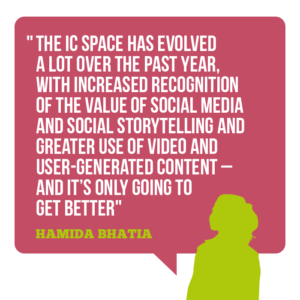
But the internal communications space has evolved a lot over the past year, with the recognition of the value of social media and social storytelling and a greater use of video and user generated content for our internal audiences – and I’m predicting that it’ll only get better.
In 2018 I’d like to see richer visual content that gives our customers a fully immersive experience when we need to influence behaviour change. And I’d like to see intelligence and measurement become more accurate and meaningful, through the help of technological advancements like AI.
I’m excited to see what this technology will bring to the industry!
Martin Flegg
Internal Communications Manager, University of Bradford
There has been quite a bit of talk in 2017 about the rise of Artificial Intelligence (AI). The implications of this for internal communications and the broader PR profession are still not well understood.
However, AI and machine learning are already beginning to encroach on communication tasks which would once have been done by humans.
My hope for internal communications in 2018 and beyond is that we don’t strip too much ‘humanity’ out of what we do in the race to adopt this new technology.
At its best, internal communications is about face-to-face and two-way interactions between the people in organisations to facilitate an exchange of ideas.
“Many organisations have already adopted new social technologies but have no meaningful strategy for how to use them internally for collaboration and conversation.”
Is 2018 the year when internal communicators will take a step back and figure out how to most effectively blend the human and technology-based approaches to our professional practice?
Dr Frederic Morrison
Course Director & Lecturer in Communication, Ulster University
Internal communication deals with complexity. So we might be tempted to see technological advances in digital communication as a solution to the challenges we face, and focus greater attention on maximizing our usage of digital channels.
But the great communication sage Marshall McLuhan offered two insights which are particularly important when we think about becoming overly focused on digital advancements.
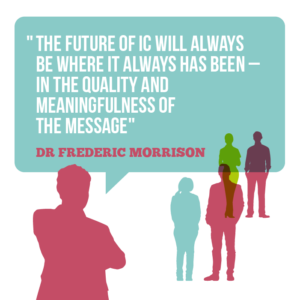
Firstly, as everyone knows, he said, “the medium is the message”. I take him to mean that the impact of different technologies alters the nature of how we relate to each other. The medium changes the listener’s perception of the communication.
The second of McLuhan’s insights suggests that “computers can do better than ever what needn’t be done at all. Making sense is still a human monopoly.” This may all sound like a rejection of digital communication channels, but that isn’t my argument.
The future of internal communication will always be where it always has been – the quality and meaningfulness of the message.
3. Addressing measurement
Eric Bruggeman
Founder, Employee Talk LLC
When gaps aren’t assessed and opportunity is not addressed, improvement doesn’t happen. Continuous engagement involves planned communications for measurement and collaboration. It’s a combination of transparent and anonymous weekly, monthly, quarterly, mid and yearly pulse dialogs.
They are specific gap assessments that focus on a target in one of four area objectives:
- Increasing Information
- Development and training
- Process or procedure
- People commitment
In 2018 my hope is that internal communicators work harder to address the measurement issue, and put tactics in place to ensure their comms can be adequately measured so as to inform future IC and engagement strategies.
Donna Burtchaell
Communications Project Manager, UCC Academy
I hope that internal communicators will look further into the potential of personalisation to increase the impact, relevancy and experience of comms for employees within the digital workplace.
“However, it boils down to having good data – the more accurate and detailed the data, the better the capacity for more personalised comms.”
As inaccurate data can harm the viability and impact of communications, I really do hope that organisations will focus on investing both time and money in getting the most reliable, granular data possible in 2018.
Who knows, maybe the arrival of GDPR is just what IC teams need – to be transparent and gain consent from stakeholders could be seen as an opportunity to ask employees to review the personal information held by the organisation, to verify it and ensure they are receiving what they actually need to know….
4. Improving the profession and its reputation
Aniisu K Verghese
India Corporate Communications Lead, Tesco Bengaluru
My hope is that there will be greater focus on developing interest among the best and brightest professionals to join and strengthen the function.
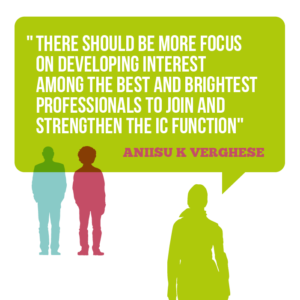
I can speak from my experience of my side of the world. Even today, after so many years, there are very few educational institutes in the region that invest in developing professionals in this industry. Likewise, there is limited collaboration among academia and professionals to blend practice with insights from IC research.
I also hope that there will be greater investment in tools and resources to help internal communications to gain greater insights into how employees think, feel and act and subsequently produce communications that are more relevant and engaging.
Ciara O’Keefe
VP Product and Customer Delivery, Staff Connect Group
I hope that internal communicators will receive more recognition, both internally and externally, for the significant work they do. With that recognition, I would like to see communicators grow in confidence and push back on requests that don’t support a positive employee experience or the company strategy.
I would like to see a continued shift from content creators to content curators. An important part of this will be holding management to account for their own communication, resulting in less ghostwriting and more upskilling leaders to communicate authentically and dynamically.
“I also want communicators to take more chances. Let’s not wait for someone else to try something – be a trailblazer and inspire others to do the same. “
And I hope internal communicators will continue to share their experiences; both failures and successes. I think the community is unique in its openness and willingness to share experiences and support each other.
Deborah Hinton
Senior Strategic Communications Consultant, Phil Communications
For some time now, I’ve hoped the internal communication conversation would be less about the function, the professionals in the function, and communication tools and tactics, and more about how the profession is playing a leading role in building the capacity of organizations to engage internal stakeholders in the mission of the organization.
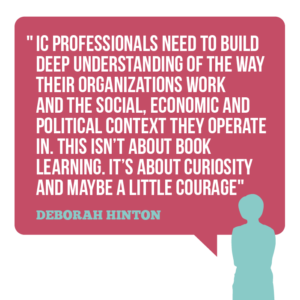
To do this IC professionals need to build deep understanding of the way their organizations work and the social, economic and political context they operate in. This isn’t about book learning. It’s about curiosity and maybe a little courage.
My hope for IC in 2018 is to see internal communicators receive mentoring from their organization’s leaders. This will ensure that IC professionals are better able to provide relevant advice and increase internal stakeholder engagement in the organizational mission – where their involvement matters most.
Let’s make 2018 the year where we break out of our bubble and increase our leadership capacity!
Marc do Amaral
Corporate & Change Communication Specialist, SPUP
My hope for 2018 is that business communicators take on the curse of short-termism. No more firefighting, reacting to everyday crises, and attending to ad-hoc requests.
“We need to think bigger and harness the potential of communication as a tool to support our organisation’s long-term strategic goals.”
Putting an end to short-termism also means facing up to the tragic misconception held by business leaders regarding the nature of communication.
Too many are adamant that when you have a plan or when something goes wrong, you just need to push the ‘right’ story into the pipeline, throw in a few town halls, and people will buy in.
As internal communicators we deserve better than being taken for granted like poor Arthur Putey from Monty Python’s famous ‘marriage guidance counsellor’ sketch. If we are to seriously contribute to strategic goals, we need to learn how to stand up and be the trusted adviser.
Priya Bates
President, Inner Strength Communication Inc.
My hope is that organizations and communication professionals embrace the power and potential of true collaboration. I want us collectively fighting for PARTNERSHIP, not OWNERSHIP.
For as long as I remember, internal communicators have been the little voice fighting for ownership of the intranet, engagement, communication vehicles. The key thought process being, ‘If we can’t own it, we can’t control it’.
It’s been a primary strategy for gaining respect and attention… but things have been changing. In today’s world of social media and the growth of Enterprise Social Networks giving employees a bigger voice, it’s increasingly difficult to establish control.
The truth is, the control model hasn’t really worked.
“I’ve always said that the greatest opportunity for strategic internal communication is not to communicate on behalf of organizations, but instead to influence how organizations, leaders and employees communicate.”
Our role becomes one of researcher, educator, coach and connector. But this role means leaving egos at the door and opening ourselves up to listening, supporting, and integrating to create the clarity and consistency that leads to the results organizations are looking for.
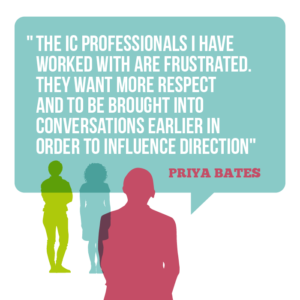
As a consultant, I’m saddened by how many organizations dismiss their internal communications talent. Many are still seen as tactical deliverers of communication materials and messages.
The professionals I have worked with are frustrated. They want more respect and to be brought into conversations earlier in order to influence direction.
In 2018, internal comms professionals need to be ready to collaborate. When you hear of a key company initiative, put your hand up to lend your communication expertise. Ask questions to leaders and employees. Listen to perspectives. Share your comms plan. And respect the expertise each person at the table brings.
By connecting communication to business strategy and collaborating with internal stakeholders to deliver results, IC professionals will be seen as an important partner linked to success.
5. Building management and leadership capability
Saskia Jones
Communications Consultant and Coach, Saskia Jones Communications
The recently released Edelman Trust Barometer shows that trust remains in crisis across the world. However, in this world of seemingly stagnant distrust, there was a sharp rise in CEO credibility over the past year.
Building trust is now the No. 1 job for CEOs, ahead of providing high-quality products and services.
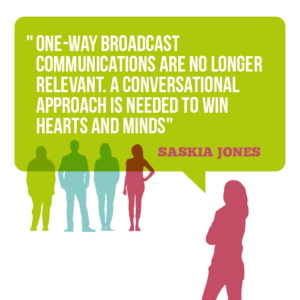
This is a big opportunity for internal communicators. We can play a significant role in helping CEOs build trust from the inside out – through a focus on authenticity, interaction and visibility.
And I hope that over the next year, this is something that internal communicators bump up their priority list.
CEOs need to share their personality and values when they communicate. They need to focus on conversations rather than broadcast communications; and they need to be accessible – ready to listen to employees and take on feedback.
Whilst CEOs might not be able to be physically present with all employees, Enterprise Social Networks should be utilised to provide new and alternative ways to interact and exchange ideas and information.
Caitlin Kirwan
Internal Communications Manager, DAS UK Group
One of my main hopes for 2018 is that line managers will begin to fully appreciate the importance of hosting regular and thorough face-to-face briefings with their teams.
Face-to-face communication is still absolutely key, especially in a digital age where employees are battling information overload on a daily basis.
A frequent, manager-led team meeting is invaluable, helping to increase employee engagement and show colleagues how the work that they do contributes to the ‘bigger picture’.
“It is the responsibility of internal communicators to ensure consistency and continuity across the business, and to provide line managers with the information they need to confidently host these sessions.”
However, it is equally the responsibility of managers and team leaders to appreciate that cascading central information and providing a clear avenue for localised employee feedback is a critical part of their role as a people manager.
Shweta Midha
Program Communication Manager, Bharti Foundation
Line managers act as pivots, and are the crucial links between senior leadership and the bottom line, enabling clear and responsible two-way communication.

As organizations are increasingly undergoing digital transformation, the earlier challenge of ‘information overload’ is being replaced with ‘information explosion’. Distinction between internal and external communication continues to blur and organizations increasingly have ‘glass doors’, so what happens within inside them isn’t invisible to the outside world.
The internal communicator’s role is to channel the most relevant information in the most effective manner and gather feedback, and line managers are vital channels to doing this successfully.
Consistent, well-meaning internal communication helps build a powerful organizational culture, and I hope that in 2018, IC professionals will continue to work with line managers to give them the skills and confidence to truly act as an effective and engaging bridge between employees and those at the top table.
Barbara Fagan-Smith
CEO, ROI Communication
According to the 2017 ROI Communication Benchmark survey of 115 large companies, one of the biggest predictors of a company’s financial performance is how effectively their managers communicate.
“Unfortunately, a recent Harris poll found that a stunning 69% of managers are actually uncomfortable communicating with the people they manage.”
So my hope for 2018 is simply that organisations provide managers at all levels with the training, support and incentives they need to communicate with confidence, clarity and authenticity.
6. Forging deeper connections
Emma Rodgers
Strategic Manager (Communications and Marketing), Stoke-on-Trent City Council
In 2018, I want to see internal communications professionals connecting more with employees, whether they are office or remote-based. It sounds like common sense and something that by now we should all have nailed but it’s not something I think you should ever take for granted.
The best organisations will regularly revisit their tools, channels and messaging to make sure they are not only effective but that they are keeping pace with our ever-changing consumer behaviour.
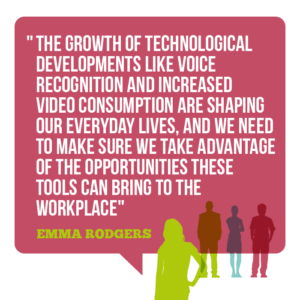
The growth of voice recognition and increased video consumption, for example, are shaping our everyday lives, and we need to make sure we take advantage of the opportunities these tools can bring to the workplace.
At the same time, we need to be certain that our approaches still hit the mark. Are there better ways to support remote workers, particularly if you’re a public-sector worker who doesn’t have an office base?
It’s about applying the same high levels of expectation and delivery to our internal communications no matter how or where our employees work.
Finally, we all know health and well-being is critical to people’s productivity and being able to do a good day’s work.
“So I’m also hoping even more will be done to build well-being into our employee engagement and communication strategies.”
The best employers will be making sure this is front-and-centre in workplace culture, and that can only be a positive thing.
Kristen Sukalac
Consulting Partner, Prospero & Partners
I hope that internal communicators will embrace their role in helping to reverse the tide of polarization and contentiousness that was so prominent in 2017.
They can achieve this by applying (and being advocates for) relational approaches to internal communications, instead of simply trying to win people over to pre-determined positions.
This means moving beyond not just the top-down model of communication, but also an oversimplified two-way model.
I hope that internal communicators recognize and harness the full richness of the human dynamics within their organizations.
“This means building bridges between different functions, but also between different worldviews and the things they value, whether that is monetary, technical expertise, rules and procedures, authority, creativity, recognition, sustainability or something else.”
It also entails recognizing the vibrant ecosystem of networks, channels and relationships in the organization, not just those captured in the formal organizational chart.
A more holistic approach makes it possible to move towards a generative model of co-creation that harnesses all the passion and energy in our organizations.
Liga Karklina
Marketing Coordinator, PROXY A/S
In 2018, I think that the internal communications focus should be on the increasing importance of video, Enterprise Social Networks and employee training.
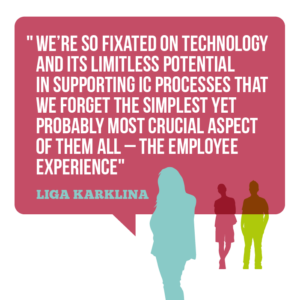
However, I personally would also like to see more time and effort invested in establishing and developing a fundamental connection between employees and the organisation as well as a connection between employees – human to human.
We are so fixated on technology and its limitless potential in supporting internal comms processes that we forget the simplest yet probably most crucial aspect of them all – the employee experience.
I am referring to organizational culture practiced through small acts of kindness that create positive emotions, where “feeling appreciated” is on the menu.
Did you know that incorporating specific traditions in an organization, reflecting its values and its culture, is an effective way of improving the employee experience?
For example, implementing a special welcome process for a new employee creates a sense of belonging and unity, making them feel like they’re being accepted into a family.
“The emphasis is on ‘feel’ because as Maya Angelou once noted, ‘People will forget what you said, people will forget what you did, but people will never forget how you made them feel.'”
I believe that implementing such practices can help strengthen organizational culture and also improve employee retention, thus lowering staff turnover.
And that’s why I hope that in 2018 we will forge stronger and more meaningful relationships between employees, so we create a truly inspiring and engaging employee experience.
So what does the 2018 hold for internal comms?
Clearly, we’ve got a lot to aspire and look forward to for internal comms in 2018.
Sure, there are many challenges and roadblocks ahead. But what happens when we flip them on their heads – and think of them as opportunities, rather than issues? A chance to improve the industry, so we can accomplish even more than we did in 2017?
As for our hope for internal comms in 2018? We hope internal communicators everywhere take sight of the insights and ideas raised here, and set about putting them to good use.
Making the world of internal communications a better place – one conversation at a time.
Thanks to all our wonderful contributors – it’s been great to feature your internal comms hopes and predictions. Keep ‘em coming!
Our bespoke internal communications and engagement programmes are tailored entirely to your organisation, workforce, and culture, and combined with a large dollop of strategic insight and ingenious creativity to ensure they deliver the results you want. If you want help in creating exceptional internal comms that really get your people buzzing, we’d love to be on your team!


